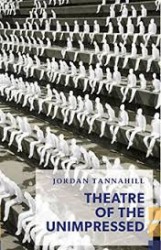Theatre of the Unimpressed:
In Search of Vital Drama
By Jordan Tannahill
Coach House Books
160 pages, $14.95
Reviewed by Joy Fisher
At 26, Jordan Tannahill was one of the youngest Governor General’s Award recipients ever when he won in the drama category in 2014 for Age of Minority, a collection of plays for young audiences exploring aspects of queer identity. With Theatre of the Unimpressed, his book-length critical essay probing malaise in English-language theatre, he demonstrates he is as talented at research and organization as at the art of playwriting.
The Toronto-based theatre practitioner spent a year interviewing theatregoers and non-theatregoers prior to writing Theatre of the Unimpressed. He divided his book into three main sections: Boredom, Liveness and Failure. In the first, Tannahill explores factors contributing to theatrical malaise. The second reports theatrical trends that signal vitality. The last Tannahill sees, along with risk-taking, as necessary to a vital theatre.
Tannahill’s basic premise is that theatre, at its best, develops our capacity for empathy and provides transformative experiences. In his view, complexity, specificity and relevance – a play’s “rigour of thinking” – are the fundamental hallmarks of resonant theatre. Boring plays lack this rigour. They: 1) “underestimate an audience’s capacity for complex argument” (play it safe); 2) lack “specificity of creative choices” (are lazy); or 3) are “unaware of context” (feel irrelevant).
Tannahill attacks, in particular, the model of the Well-Made Play which he asserts has dominated Western theatre since the nineteenth century. Well-made plays are based on psychological realism and explore conflicts “through conversation on the battlegrounds of middleclass parlours.” Well-made Canadian plays come in for a particular drubbing: too often they are “multi-generational narratives in which someone is finding their identity and in which Canada is also finding its identity.” Reverence for the well-made play, Tannahill believes, has also contributed to a dramaturgical system that attempts to “fix” scripts that don’t fit into the mold of the well-made play, with the result that “the life is sucked out of them.”
Classics also suffer, though for other reasons. Their difficult questions disguised by geographical and temporal distance, costumes and production values, they become what Tannahill calls Museum Theatre: mere relics from the past, “harmless effigies of their once fierce and mighty selves.”
Money is also a factor. (Anyone familiar with the City of Victoria’s recent complaints over the costs of upkeep for the McPherson Playhouse will recognize this economic reality.) Artistic directors, in need of money to pay for upkeep on the imposing physical structures of large regional theatres, stick to traditional well-made plays because they trust their audiences to support them. Ironically, audiences hungry for transformative experiences develop a taste for well-made plays because that’s what artistic directors give them as a steady diet.
The problem is complicated, Tannahill argues, by a system of arts councils that have bought into the model of perpetual growth upon which free market capitalism is based. One of my friends, an artistic director trying to buck this trend by keeping ticket prices low to attract a younger, less well-heeled crowd, has confided his frustrations on this score. Because he can’t demonstrate his theatre is increasingly profitable, he risks losing continued art council funding.
While I agreed with Tannahill’s clear elucidation of the problems that interfere with achieving transformational theatre, I sometimes found his proffered solutions alarming.
For example, Tannahill embraces the auteur theory of directing, common in the film industry, which allows directors to subvert the scriptwriter’s intentions. In traditional theatre, the playwright is regarded as the creative mother of the play, and the director as its midwife. Together, they give birth to new life. Directors who deliberately subvert the meaning of a play can turn the newborn into a deformed thing. I saw that happen not long ago when a male director intentionally subverted the meaning of a feminist play from the 1980s because he thought it would not resonate with the audience in what he considered to be a post-feminist world. It was like watching an abortion.
Furthermore, although Tannahill concedes that the well-made play can contain the spark of liveness that produces a transformational experience, he tends to look to the experimental for that result. He also extols the strange notion of constructed failure—incorporating into the performance something that deliberately fails in order to startle the audience into response. While admitting that could be considered cynical, Tannahill considers it to be a powerful antidote to a mass-mediated culture in which “polish, poise and conventional aptitude are rewarded.” To me, the notion of constructed failure smacks of disrespect for the audience, an attempt to trick them into responsiveness.
Tannahill has written a well-researched analysis of what ails contemporary English-language theatre that will inform anyone who loves live theatre and wants to see it thrive. Just remember to don your critical thinking cap when you consider his proposed solutions.
Joy Fisher is a Victoria playwright and theatre lover.

{ 0 comments… add one now }